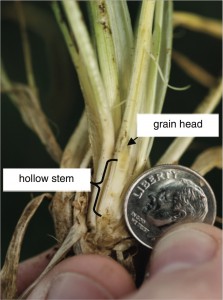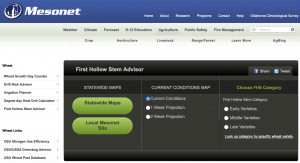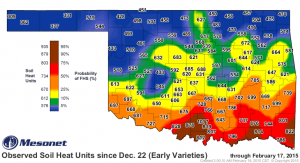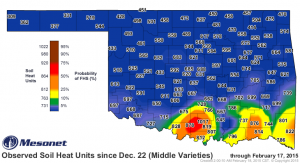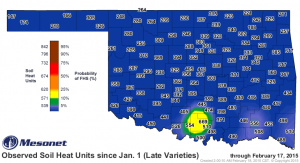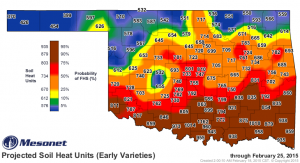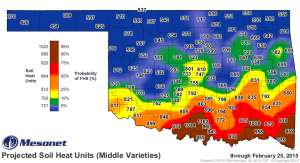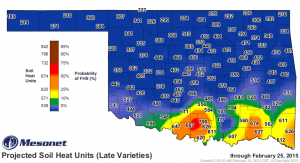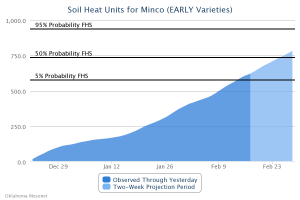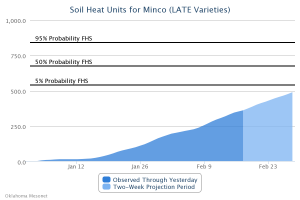In the Great Plains, wheat and cattle go together like beef and potatoes, pancakes and syrup, bread and butter. Wheat is a great winter forage. Cattle love it and its excellent for weight gain.
Farmers and ranchers have a choice to graze wheat and skip grain production or pull cattle in late winter and allow the wheat plant enough time to produce grain. To grow wheat as a dual-purpose crop, make the most of grazing, and still produce a good grain crop, wheat growers pay attention to first hollow stem.
Here on February 18th, we are on top of the time when wheat has or soon will reach the first hollow stem stage. To check for first hollow stem, growers pull four to five plants in a non-grazed area and split the stems open lengthwise starting from the base, with a sharp razor or box cutter. If there is an average of 5/8 inch of hollow stem below the developing wheat head, the wheat is at first hollow stem.
To help producers better schedule when to check wheat for first hollow stem, the Oklahoma Mesonet introduced the First Hollow Stem Advisor in 2014 thanks to the work of OSU faculty Dr. J. D. Carlson and Dr. Jeff Edwards.
[Full Site: Mesonet.org / Agriculture / Crop / Wheat / First Hollow Stem Advisor (also under Cattle)]
[Mobile Apps and website, m.Mesonet.org: Maps / Agricultural Advisories
Statewide maps are available to get a geographical perspective of how far along wheat is across the state for all three first hollow stem groups: early, middle, and late.
It’s time to check wheat fields when accumulated soil heat units indicate a 5% probability that wheat has reached first hollow stem. This corresponds to the green map color. The 5% probability means that in one out of 20 years or 5 out of 100 years wheat would have reached first hollow stem by this date.
If no scouting is done, it is recommended that cattle be removed by the 50% probability date.
Wheat varieties commonly grown in Oklahoma have been grouped into one of three categories based on when they reach first hollow stem. The first hollow stem stage grouping may or may not correspond to its grouping for harvest maturity.
2015 Wheat First Hollow Stem Variety Category
The Mesonet First Hollow Stem Advisor uses a daily average of 4-inch soil temperature under vegetation to estimate soil heat units that drive wheat growth and maturity. For early and middle varieties, heat units above 31 degrees F are accumulated from December 22nd. Late variety heat units are those above 34 degrees F accumulated since January 1st. The difference in base temperature and beginning date are why late first hollow stem varieties have the lowest soil heat units at first hollow stem, but reach first hollow stem later in the season.
To look ahead the Mesonet First Hollow Stem Advisor has one-week and two-week projections for first hollow stem based on the long-term averages for each Mesonet site. Here are one-week projections as of February 18, 2015.
Time series graphs let growers chart the progress of the probability of first hollow stem for individual Mesonet sites. Here are charts for the Minco Mesonet site from February 18, 2015 for the three first hollow stem groups. Tables of the graphed data are also available on the full Mesonet website.
Farmers and ranchers that grow wheat for winter grazing and spring grain production, know how quickly wheat grain yield can decline if the wheat is grazed after first hollow stem. It is estimated that under ideal wheat growing conditions through the rest of the growing season, cooler and wetter weather, grazing past first hollow stem would reduce grain yield by 14%. If the weather turns off warmer and dryer, grain losses could be as high as 58% from two weeks of grazing past first hollow stem.
Refer to these OSU fact sheets for more information.
First Hollow Stem: A Critical Wheat Growth Stage for Dual-purpose Producers. OSU Fact Sheet #PSS-2147. Jeff Edwards and Gerald Horn. Jan 2010.
The Effect of Grazing Past First Hollow Stem on Wheat and Stocker Profits. OSU Fact Sheet #AGEC-265. E.A. DeVuyst, F.M. Epplin, K.W. Taylor, G.W.Horn, J.T. Edwards. Feb 2011.
